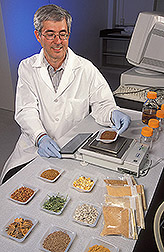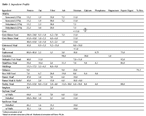Evaluating Feed Components and Finished Feeds: Part 1

Tim Herrman
Extension State Leader
Grain Science and Industry
Kansas State University
Ingredient quality is the foundation upon which an animal ration is built. Therefore, establishing an ingredient quality evaluation program is an essential component of a successful feed processing operation. Routine evaluation of finished feed quality will help ensure that proper ingredient storage, proportioning, grinding, and mixing were performed. This bulletin contains information pertaining to ingredient specifications, suggestions on which feed ingredient and finished feed properties should be analyzed, types of assays to perform, and how to interpret lab results. The first step in evaluating ingredients and finished feed quality involves collecting a representative sample as described in the bulletin, Sampling: Procedures for Feed (Herrman 2001).
Ingredient Specifications.
Ingredient specifications are essential to a quality assurance program. Specifications serve as the basis from which purchasing agreements are written, feed rations are formulated, and ingredient inspections are performed. Ingredient descriptions and general nutritional specifications may be found in the following publications: AFIA Feed Ingredient Guide II (American Feed Industry Association (AFIA), 1992), the Association of American Feed Control Officials(AAFCO) Official Publication (2000), and the Feedstuffs Reference Issue (2001). A partial list of nutritional properties of these ingredients are in Table 1.
Sensory and Physical Properties
Sensory property evaluation, including inspection of ingredient color, odor, texture, moisture, temperature, and a visual inspection for physical purity (absence of foreign material and insect infestation) enables one to quickly assess whether the ingredient should be rejected. It also enables the person responsible for receiving the ingredient to confirm product identity (same as re- corded on the bill of lading). The inspection process should be accompanied by a reference sample for comparison. Physical property evaluation usually involves testing incoming grain and feed ingredients for bulk density, purity, and texture. All of these properties will determine how the material unloads, conveys into and out of bins, stores, and performs during processes.
Bulk density of a material represents the mass per unit volume. This characteristic is commonly ex- 3) or kilograms pressed as pounds per cubic foot (lb/ft 3 ). The bulk density of a material per cubic meter (kg/m is measured by weighing the amount of material that fills a one-cubic-foot box. Bulk density can vary significantly for the same ingredient due to differences in particle size, moisture content, or compaction. Bulk density of a feed ingredient is important for inventory control purposes and will determine how the ingredient will perform during batching and blending. When a feed ration requires blending ingredients that differ widely in bulk density, the feed processor should ensure that the particle size of the feed ingredients is similar, use a binding agent (fat or molasses), and load the mixer using an ingredient sequence that optimizes the blending action of the mixer. For example, high- density ingredients should be added early to vertical mixers and late in the batching sequence for horizontal mixers.
Test weight is a bulk density measurement applied to grain, and the value represents the weight (expressed as pounds) in a Winchester bushel (2150.42 cubic inches). Specifications for test weights of different grains and grades are presented in the bulletin Grain Grading Standards in Feed Manufacturing (Herrman and Kuhl, 1997). The procedure for measuring test weight is included in separate bulletins listing the grains' name (e.g., Corn: Grading Procedures, 2000).
Ingredient purity refers to the absence of contaminants. The source of these contaminants may be physical (e.g., glass), chemical (e.g., seed treatment), and microbial (e.g., mycotoxin). The use of hand sieves to inspect for physical contaminants enables rapid evaluation of material. For example, the use of two sieves (12/64-inch round-holed sieve placed on top of a 5/64-inch round hole sieve) separates dockage (non- wheat material) from wheat. The material on the top sieve and the pan underneath the bottom sieve contain dockage. Visual inspection is then performed on the dockage-free wheat (wheat on top of the 5/64-inch sieve) to identify non-wheat material which is referred to as foreign material. Chemical and microbial contaminants can be performed by laboratories listed at the back of this bulletin (Table 2 and Table 3).
Further details on analyses for microbial contaminants and their effect on animal performance are presented in the following bulletins: Mycotoxins in Feed Grains and Ingredients (TrigoStockli and Herrman, 2000) and Quality Management for Feed Related Disease Prevention (Herrman and Stokka, 2001).
Texture of an ingredient is measured visually and with sieves. Soybean meal texture is described visually as "homogeneous, free-flowing, without coarse particles or excessive fines" (AFIA, 1992). Soybean meal texture measured by sieve analysis is described as "95 to 100 percent through U.S. Standard Sieve No. 10; 40 to 60 percent through U.S. Standard Sieve No. 20; and a maximum 6 percent through U.S. Standard Sieve No. 80" (AFIA, 1992). For further information about sieves and particle-size analysis, refer to the bulletin titled Evaluating Particle Size (Herrman, 2001).
Nutritional Properties
Nutritional properties of feed ingredients require laboratory analysis; this usually entails expensive analytical equipment operated by professional chem- ists. Many feed companies use commercial labs for these analyses (Table 1). Most analysis techniques involve the use of procedures tested and approved by scientific organizations such as the Association of Official Analytical Chemists' (AOAC, 2000) Official Methods of Analysis and the American Association of Cereal Chemists' (AACC, 1995) Approved Methods of Analysis.
Other Parts to this Article







